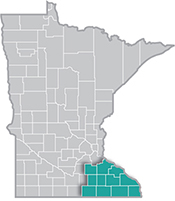 Southeast Minnesota is a health care and agricultural powerhouse. The region is home to the renowned Mayo Clinic and some of the world's most recognized food companies and brands.
Southeast Minnesota is a health care and agricultural powerhouse. The region is home to the renowned Mayo Clinic and some of the world's most recognized food companies and brands.
Advanced manufacturing is especially strong here, with machinery, chemicals, and electronics among the top products.
Want the freshest data delivered by email? Subscribe to our regional newsletters.
4/3/2018 9:47:04 AM
The recent fourth quarter 2017 data release of DEED's Job Vacancy Survey shows that there were almost 11,000 job openings in Southeast Minnesota – 10,820 to be exact. The highest number of those vacancies were in sales and related occupations, food preparation and serving related, personal care and service, and healthcare practitioners and technical – each seeing more than 1,000 vacancies – with sales and related seeing over 1,500 vacancies (Figure 1).
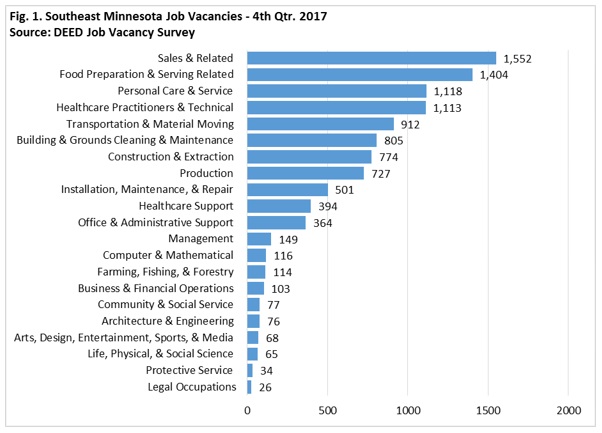
This vacancy estimate in Southeast Minnesota is almost 30 percent higher than a year ago, when there were only 8,347 vacancies in the fourth quarter of 2016. The most significant increases occurred in construction and extraction, personal care and service, and transportation and material moving occupations, which all saw an increase of over 560 vacancies. Sales and related jumped by over 460.
However, some occupational groups saw a decrease in vacancies in the past year, including a drop of over 200 for food preparation and serving related, over 150 fewer for business and financial operations as well as healthcare support occupations, and a decline of over 100 for community and social service occupations (Table 1).
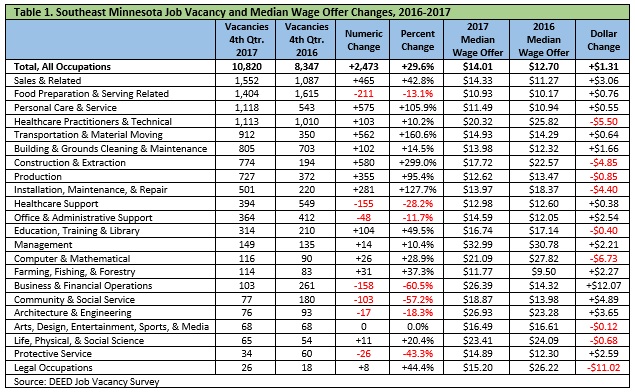
Since last year, changes in median wage offers were all over the board, with increases ranging from $0.38 cents per hour in healthcare support to $12.07 for business and financial occupations and decreases from $0.12 cents per hour in arts, design, entertainment, sports and media to $11.02 in legal occupations.
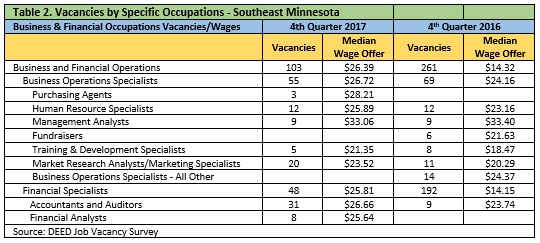
These wage changes are likely due to the changing nature of the specific occupations that were posted. As the example in Table 2 shows, there were differences in the number of occupational openings as well as subsequent wage offers for the openings in the broad business and financial operations group. There were more vacancies for this broad group in the fourth quarter of 2016 than in 2017, however a good portion of those 2016 vacancies were in the financial specialists sub-group with a median wage offer of $14.15, versus only 48 vacancies in this sub-group in 2017 with a median wage offer of $25.81. More specifically, during the 4th quarter of 2017 there were more accountants and auditors (31) with a higher median wage offer ($26.66) than there were in 2016, when there were only nine vacancies for accountants and auditors with a lower median wage offer of $23.74.
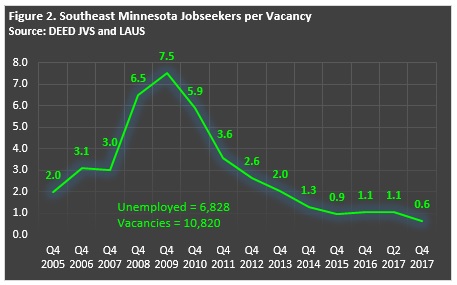
From a job seeker standpoint, having a lot of vacancies may be of benefit as it offers many opportunities for potential employment. While these employment opportunities are fewer in number in some occupational groups, such as legal and protective service, there are current vacancies in all occupational groups.
However, when the number of current job seekers – based on the number of unemployed workers – is taken into consideration along with these vacancies, a startling issue arises – the region now has a 0.6 job seekers per vacancy ratio. That is, for every ten job openings in the region there are only six people looking for work! The benefit for some job seekers could mean less competition for jobs, but this makes it difficult for employers to fill their current openings. And therein lies the job vacancy conundrum in Southeast Minnesota – loads of vacancies with not enough job seekers (Figure 2).
Contact Mark Schultz.